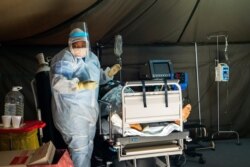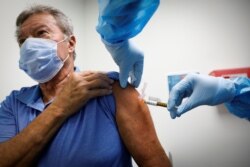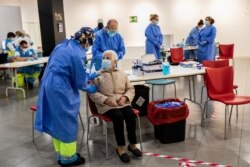The U.S. Centers for Disease Control and Prevention is now acknowledging that COVID-19 can spread through small particles in the air over an extended distance and for hours at a time.
The CDC has long insisted that the coronavirus is transmitted mainly between people standing within two meters of each other, through droplets produced by talking, breathing, coughing or sneezing.
But the agency updated its guidelines on its website Monday citing evidence from previous research that the virus can linger in the air through small droplets known as aerosols in “limited, uncommon circumstances” where someone with COVID-19 infected others more than two centimeters away or shortly after the infected person left an area.
The updated guidelines say the transmission in such instances “occurred in poorly ventilated and enclosed spaces that often involved activities that caused heavier breathing, like singing or exercise,” which may contribute to “the buildup of virus-carrying particles.”
The CDC posted a similar guidance last month suggesting the virus could spread through aerosols over an extended distance. But the agency abruptly removed the guidance a few days later, saying it was mistakenly posted before it had gone through a proper technical review.
The method of how COVID-19 is transmitted has been under intense debate among health experts for months. Back in July, more than 200 scientists from over 30 countries published an open letter to the World Health Organization urging the agency to consider evidence that the virus can be spread through airborne transmission.
Another study released Monday reveals that nearly a third of hospitalized COVID-19 patients experienced some type of neurological disorder, including confusion, headaches, confusion, dizziness or muscle pain. Researchers observed the outcomes of more than 500 coronavirus patients admitted to a hospital system in Chicago between March and April, the earliest days of the outbreak in the U.S.
The researchers found that only 32% of the patients with neurological problems were able to handle routine daily activities after being released, like cooking or handling financial issues, compared to 89% of patients who did not have such problems. The researchers said the most severe neurological symptom was encephalopathy, which is characterized by “altered mental function ranging from mild confusion to coma.”
Meanwhile, several U.S. news outlets say the White House has rejected a proposal by the U.S. Food and Drug Administration to implement a set of strict new guidelines for emergency authorization of a new COVID-19 vaccine.
The new rules — which would have required drug makers to observe participants in late-stage clinical trials for at least two months after they receive a second and final dose of an experimental vaccine — would have certainly pushed a possible vaccine well past the November 3 presidential election, defying predictions made by President Donald Trump.
The World Health Organization says roughly one in 10 people around the world may have been infected with the coronavirus.
The head of the health emergencies program at the World Health Organization, Michael Ryan, said Monday that the agency's “best estimates” indicate 10% of the world’s population could have contracted the virus.
That estimate, which would amount to more than 760 million people, is more than 20 times the number of confirmed cases in the world and would still leave more than 90% of the population susceptible to the virus.
Speaking to a special session of WHO’s 34-member executive board in Geneva, Ryan said the figures vary between countries, but said the estimate means “the vast majority of the world remains at risk.”
“We are now heading into a difficult period,” he said.
The number of confirmed worldwide cases tallied by the Johns Hopkins Coronavirus Resource Center surpassed 35 million on Monday, a week after surpassing 1 million coronavirus deaths.
Several European nations hit their own pandemic milestones, with Germany reporting Monday its total confirmed cases exceed 300,000, Britain recording its 500,000th case, and Spain becoming the first European country to surpass 800,000 total coronavirus cases.














